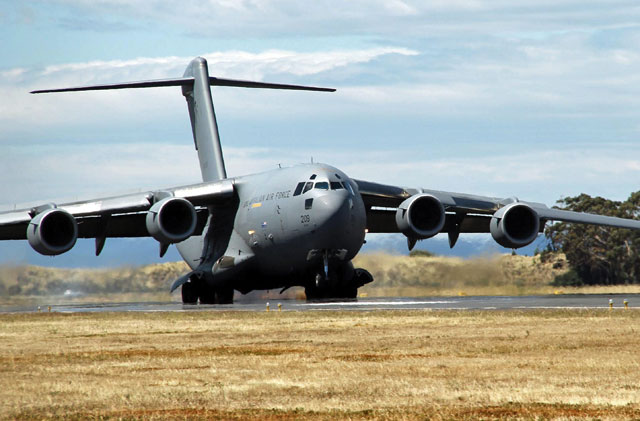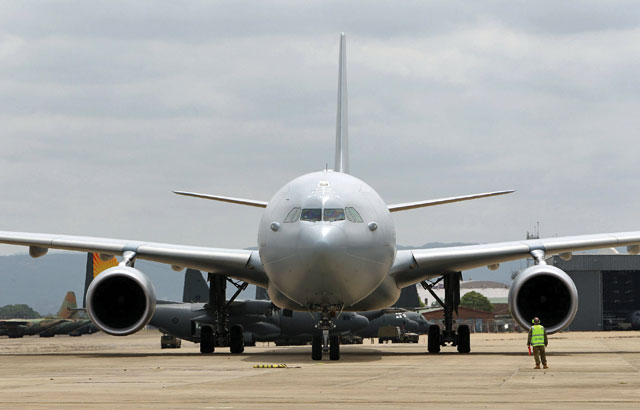The big news at the 2011 Avalon show was Australia's decision to obtain a fifth Boeing C-17 strategic airlifter. Two years on, this aircraft has arrived and another C-17 has been ordered and delivered, bringing the Royal Australian Air Force's total of the type to six examples. When asked about how this has changed, Canberra's Airlift Group commander Air Cdre Gary Martin uses only one word: "Unbelievably."
Martin says the C-17 has revolutionised the RAAF's ability to travel rapidly between points with more than five times as much cargo per flight as the Lockheed Martin C-130. In one airlift operation between the United Arab Emirates and Afghanistan in September 2012, a single C-17 moved cargo weighing one million pounds, much of it outsized, in only four days. He estimates it would have taken two C-130s two months to transport the same payload.
 |
|---|
| Australian defence ministry C-17s have revolutionised Australian airlift |
The C-17 is emblematic of a broader transformation of the RAAF's airlift capabilities. In the 10 years from 2006 to 2016, the RAAF's airlift fleet will drop to 46 from 47 aircraft, but this slight decline will be more than made up for with capacity, which will rise to 965t from 673t, or 4,441 passengers from 3,931. The average age of the fleet in 2016 will fall to only nine years, compared with 24 years in 2006.
While engine power, range and speed will grow, costs to support the fleet should fall. What is more, RAAF airlift assets will no longer require navigators and flight engineers following the retirement last year of the C-130H.
Aside from supporting Canberra's contribution to the war in Afghanistan, RAAF C-17s have supported relief efforts for a range of humanitarian crises. In March 2011, RAAF C-17s supported relief efforts following the tsunami and earthquake in Japan. C-17s have also supported relief efforts that followed natural disasters in Australia and New Zealand.
Despite its extensive use of the C-17 - Martin says that at any given moment one aircraft is likely to be airborne - Canberra has yet to fully utilise the type's capabilities. It is exploring the type's suitability for air drops in support of naval operations, including air dropping rigid-hull boats for special forces.
And although C-17s are equipped to receive fuel via a boom, this capability has yet to be implemented. Eventually, the RAAF will be able to refuel its C-17s via the boom that equips its Airbus Military A330 multirole tanker transports - designated KC-30A in RAAF service.
Canberra received its full complement of five KC-30As between 2011 and 2013. Martin says initial operating capability (IOC) is likely in the first quarter of 2013. The IOC includes the ability to refuel the F/A-18A/B through the hose-and-drogue method, and the carriage of passengers. The RAAF's first KC-30A has returned to Spain, where remedial work is ongoing to improve stability of fuel flow in the boom. Software to control the boom also needs to be upgraded before the equipment can be used operationally.
 |
|---|
| Australian defence ministry The RAAF has evolved into the Asia-Pacific region's most capable airlift player |
The other significant new type planned for the RAAF Airlift Group is the Alenia Aermacchi C-27J, of which 10 will be obtained under the US Foreign Military Sales mechanism. The C-27J replaces the de Havilland Canada DHC-4 Caribou, which was retired in 2009.
Although the Caribou was popular with RAAF crews, the C-27J is an eminently more capable aircraft. It is more powerful and will be equipped with armour and directional infrared countermeasures.
Martin says the main attribute which aided its selection over Airbus Military's rival bid with the C295 was the C-27J's cargo capacity: "If you look at the internal size of the aircraft, the C295 could not fit vehicles such as the Land Rover replacement or special forces vehicles. The C-27J came out well on top in these areas."
The balance of the fleet is rounded out by 12 C-130Js - delivered between 1999 and 2002 - and eight Beechcraft King Air 350s. The RAAF Airlift Group also operates five charter jets for VIP transport, three Bombardier Challenger 604s, and two Boeing Business Jets.
When the C-27J arrives, Canberra will have a powerful array of airlift capabilities. This will serve it well during war and peace in the 21st century.
Source: Flight International


























